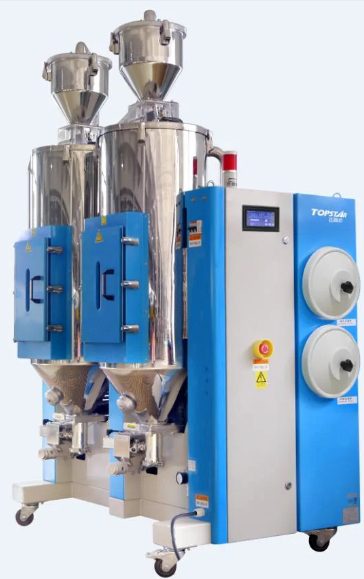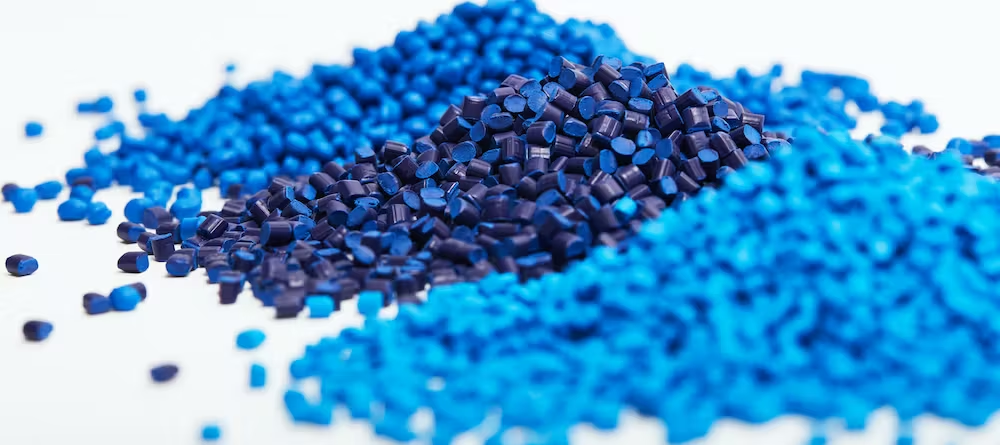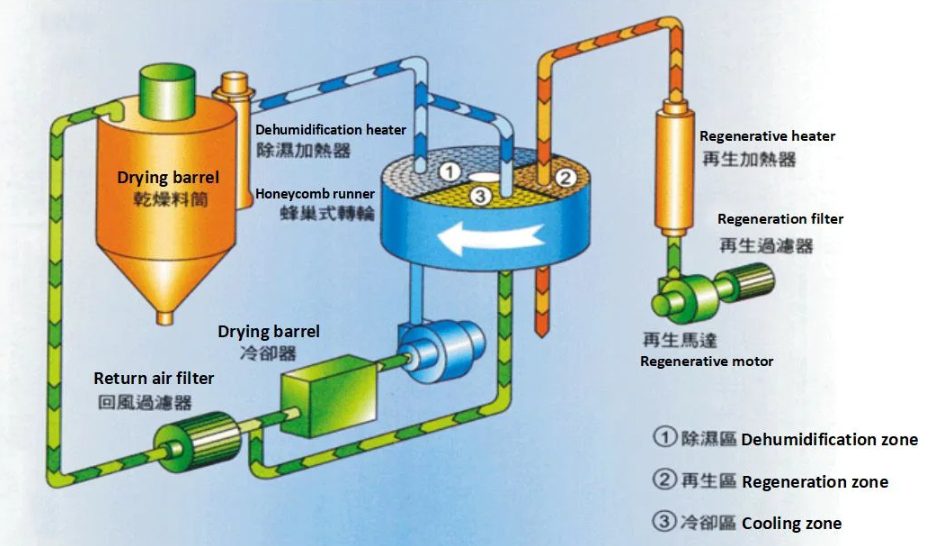Ways to prevent material degradation in Stainless Hopper Dryer
2023/12/23 By Topstar

If you want to maintain the integrity of the material and get a high-quality end product, then choosing a Stainless Hopper Dryer can help you do it. Stainless steel hopper dryers are vital in injection molding, ensuring the material does not degrade. This guide will also tell operators key ways to prevent material degradation effectively.
Control moisture content
Moisture can cause corrosion on the stainless steel components of your Stainless Hopper Dryer. Stainless steel is resistant to corrosion, but prolonged exposure to humidity can compromise its integrity, possibly leading to rust and deterioration. Secondly, moisture content directly affects material quality. Excess moisture in the material can cause clumping, clumping, or degradation, which can negatively impact the consistency and quality of the final product. Proper moisture control in a stainless steel hopper dryer ensures that materials remain in optimal processing condition, helping to produce a high-quality end product. Additionally, moisture in the Stainless Hopper Dryer can reduce the efficiency of the drying process. The presence of humidity requires additional energy to evaporate during the drying process, thereby extending processing time and increasing energy consumption.
Effect of temperature of Stainless Hopper Dryer on materials
Temperature directly affects the dehumidification efficiency of the drying process. Maintaining an optimal temperature within the Stainless Hopper Dryer promotes faster and more efficient evaporation of moisture from the material, ensuring a thorough and efficient drying process. This dehumidification precision is essential to prevent material degradation. Temperature control affects the overall consistency and quality of the dried material. Different materials have specific temperature requirements, and operators must select based on various material temperatures to achieve optimal drying. In addition, we must prevent the temperature from overheating, which will cause thermal degradation of the material. The Stainless Hopper Dryers offered by us are equipped with a precise temperature regulation mechanism that prevents excessive heating, protects the integrity of the material and avoids undesirable changes in its physical or chemical properties.

Selection of materials for Stainless Hopper Dryer
High-quality corrosion-resistant stainless steel can be selected, such as 304 or 316 grade, which ensures the longevity of the hopper dryer components and protects them from degradation, especially when exposed to moisture or corrosive materials. Choose materials that can withstand the temperature changes inherent in the drying process. Components such as drying chambers and internal components are exposed to high temperatures where structural integrity and mechanical properties can be maintained. Different materials may react with each other, potentially causing contamination or adverse reactions. Ensuring compatibility is critical, especially when working with polymers or materials with specific chemical sensitivities.
Routine maintenance to prevent degradation
Operators must perform routine maintenance on Stainless Hopper Dryers to prevent degradation. Clean your stainless hopper dryer’s interior and exterior surfaces regularly to remove dust, debris, or residue build-up. This prevents contamination and maintains an efficient drying process. Check seals and gaskets for wear or damage. Damaged seals will cause air leakage and affect drying efficiency. Lubricate moving parts, such as hinges and bearings, to reduce friction and ensure smooth operation. Also, clean or replace the filter regularly to prevent clogging. A clogged filter will impede airflow and reduce drying efficiency. Clean filters promote consistent and efficient material drying.
Load correctly to prevent degradation
Properly loading stainless steel hopper dryers is crucial to prevent material degradation and ensure efficient drying. Before loading, ensure hoppers and related equipment are thoroughly cleaned to avoid cross-contamination between different materials. Contaminants can damage material quality. Make sure the material size fits the capacity and design of the hopper. Overloading or underloading the hopper will affect drying efficiency and lead to uneven drying results. Certain materials may form bridges or clumps in the hopper, impeding material flow. Use appropriate measures, such as vibration or stirring, to prevent material bridging and ensure continuous flow. Consider the recommended drying temperature of the material. Make sure your hopper dryer is set to the correct temperature for effective dehumidification without the risk of material degradation.

At last
Our operators must carefully select the materials suitable for the stainless steel hopper dryer and understand their characteristics when working daily. The characteristics of the dryer are used to prevent the possibility of degradation. Follow the tips in this guide to get the best out of your dryer!
TRENDING POSTS
HOT TOPIC
- 3 in 1 Compact Dehumidifying Dryer
- accuracy
- Air Chillers
- all electric injection molding machine
- All-electric injection molding machines
- and overall production quality. Therefore
- AP-RubberPlas
- automated injection molding machine
- Automation changed engineering
- automation of injection molding robots
- auxiliary machine
- Bench Injection Molding Machine
- Cabinet dryer manufacturers
- Cabinet dryers
- CNC Drilling Machine
- CNC Drilling Machines
- cnc engraving machine manufacturer
- cnc laser cutting machine manufacturer
- CNC machine
- CNC Machine Center
- CNC Machine for Sale
- CNC Machine Manufacturing
- CNC Machine Tool
- CNC machine tool product
- CNC Machining Center
- CNC wood carving machine
- Cooling system
- Cross-Walking Single Axis Servo Cylinder Robot
- Cross-Walking Single-Axis Servo Cylinder Robot
- Cross-Walking Three-Axis/Five-Axis Servo Driven Robot
- cross-walking three-axis/five-axis servo-driven robot
- Dehumidifier Dryer
- delta parallel robot
- Desktop Injection Molding Machine
- Desktop injection molding machines
- Desktop Molding Machine
- desktop plastic injection machine
- Desktop Plastic Injection Molding Machine
- direct clamp injection molding machine
- Direct clamp injection molding machines
- Dosing & mixing system
- Drilling Centers
- Drying and dehumidification system
- drying and dehumidifying equipment
- Drying and Dehumidifying System
- drying system
- effective and efficient. Cabinet dryers are also used in other industries where large quantities of material need to be dried
- efficient injection molding machine
- elbow hydraulic injection molding machines
- electric injection molding machine
- etc. Among injection molding robots
- exhibition
- features of CNC machine
- Feeding And Conveying System
- Five Axis Machine Center
- Fully automatic injection molding machine
- Gathering Topstar
- giant injection molding machine
- GMU-600 5-Axis Machining Center
- Granulating & Recycling System
- Heavy duty injection molding machine
- Honeycomb rotor dehumidifier
- horizontal injection molding machine
- Horizontal Injection Molding Machines
- Horizontal Injection Moulding Machine
- Horizontal Mixer manufacturer
- How The CNC Machine Works
- hybrid injection molding machine
- hydraulic injection molding machine
- Hydraulic Injection Molding Machines
- in this article
- Industrial robot
- Industrial Robot Chinese brand
- industrial robot parts
- industrial robot supplier
- Industrial robots
- Industry Chain
- Injection Manipulator
- Injection molding
- Injection molding automation
- Injection Molding Automation Solution
- injection molding dryer
- Injection molding equipment
- injection molding hopper dryer
- Injection molding machine
- injection molding machine brand
- Injection Molding Machine Factory
- Injection Molding Machine Manufacture
- Injection molding machine manufacturer
- injection molding machine manufacturers
- Injection molding machine procurement
- injection molding machine robotic arm
- injection molding machine with a robot
- Injection molding machines
- injection molding material dehumidifying
- injection molding plant
- Injection Molding Robot
- injection molding robot arm
- Injection molding robot automation
- Injection molding robotic arm
- injection molding robots
- Injection Moulding Robots
- Injection Robot
- Injection robot arm
- Injection robot manufacturer
- Injection robot wholesale
- injection robots
- Introducing Injection Robot
- It is the best choice for drying large quantities of material at once. Cabinetmakers use these machines because they are fast
- large injection molding machine
- Learn what industrial automation and robotics is
- low speed sound-proof granulator
- machine plastic molding
- make sure to add some! Improvements (2) Keyphrase in introduction: Your keyphrase or its synonyms appear in the first paragraph of the copy
- manipulator machine
- manufacturing
- micro injection molding machine
- middle speed granulator
- Mini CNC machine manufacturers.
- Mold Temperature Control System
- mold temperature controller
- molding material Dehumidifying System
- mould temperature controller
- New electric injection molding machine
- nitrogen dryer manufacturer
- nitrogen dryer system manufacturer
- Oil type mold temperature controller
- open day
- Outbound links: No outbound links appear in this page. Add some! Images: No images appear on this page. Add some! Internal links: No internal links appear in this page
- PET Preform injection molding
- phone case making machine
- plastic bottle making machine
- plastic bottle manufacturing
- plastic bucket making machine
- plastic bucket manufacturing
- Plastic chair making machine
- plastic forming equipment
- plastic hopper dryer
- plastic injection machine
- plastic injection machines
- plastic injection molding
- Plastic injection molding machine
- Plastic Injection Molding Machines
- plastic injection robot
- Plastic Molding machine
- plastic molding press
- plastic phone case making machine
- plastic-molding machine
- powerful granulator
- Powerful Type Sound-Proof Granulator
- production of plastic seats
- Robot injection molding
- robot injection molding machine
- robot manufacturing companies
- Robotic arm for injection molding machine
- robotic injection molding machines
- robotics in injection molding
- SCARA robot
- Service-oriented manufacturing
- Servo Cylinder Robot
- servo driven robot
- Servo Driven Robots
- servo injection robots
- Servo-Driven Robot
- Setup of injection machine
- Silicone Injection Molding Machine
- six-axis industrial robot
- Stainless Hopper Dryer
- Stainless Hopper Dryers
- star club
- swing arm robot
- the choice between servo-driven robots and hydraulic robots will have a certain impact on efficiency
- the most popular injection molding machine
- the type of injection molding robot
- toggle clamp injection molding machine
- Toggle Hydraulic Injection Molding Machines
- toggle injection molding machine
- Top 10 brands of injection robots
- Topstar
- Topstar Engineering
- Topstar injection molding intelligent
- Topstar Scara Robots
- Useful Injection molding machine
- Vertical machining centers
- volumetric type blender
- water distributor
- Water Type MoldTemperature Controller
- We often face choices when performing injection molding. We will choose the type of injection molding machine
- wholesale of injection molding machines
- x carve CNC
